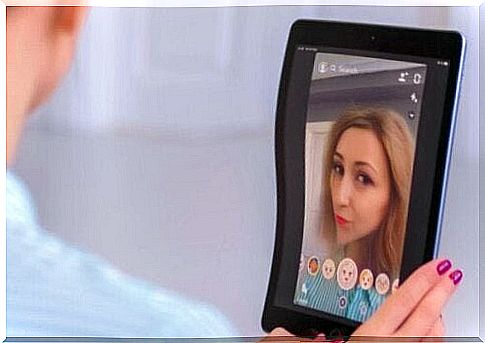Self-dysmorphy, Living One’s Life Through Filters On Social Networks

Not so long ago, some of us probably dreamed of looking like Angelina Jolie, Brad Pitt or Johnny Depp. But today, things have changed a lot. Today , in fact, more and more people suffer from what is known as selfie dysmorphia.
This disorder defines an obsession. It is the desire to want to be what you see on your mobile. This filter universe presents enhanced and ideal images, and it seems that this is what we are all looking for. The best version of ourselves. We retouch our faces via the addictive Snapchat app. We give ourselves smaller noses, bigger eyes, higher cheekbones… the list can be made long.
In fact, some people barely look at the real world. They spend most of their days in front of a screen that, like some strange enchantment or magic mirror, always shows them a seductive, perfect and captivating image. These people take between 25 and 50 selfies a day. Also, hardly surprisingly, they do not have the strength to see themselves in the bathroom mirror. This is because it speaks the truth and does not hide the dark circles or double chin.
Technology can be both wonderful and useful. This as long as we use it wisely. However, it attracts some people to behaviors that often fall within the pathological. Let’s take a look at the specific disorder selfie dysmorphy that has so far not been included in any diagnostic manual.

Selfie dysmorphy
Some people get upset by disorders like selfie dysmorphia. “When will it end?” They ask. They see this condition as one of the most confusing in recent years. However, there is one thing we must take into account. The fact that the world continues to move forward and with each era comes some strange conditions in behavioral science and psychological health.
For example, it was not so long ago that young people requested cosmetic surgery because they wanted to look like Barbie dolls. Nowadays, new technology and apps fill our lives with filters and beautify everything. Along with this comes new psychological disorders.
In this parallel universe, the mundane and the ordinary have no place. In fact, ordinary and ordinary faces become extraordinary, like something out of a Disney movie.
The clinical field has been warning about the consequences of the selfie regarding mental health for a long time. For example, the University of York in Toronto (Canada) conducted research that mentioned how the need to take selfies and publish them continuously is correlated with lower self-esteem, feelings of insecurity and social anxiety.
Undoubtedly, we are in a time where image is everything. But what is strange is that we humans feel more insecure than ever with our physical appearance.
The digital universe and psychological problems
Not everything you see on your social networks is genuine. In fact, there is a proliferation of fake news and fake accounts. In addition, the photos and selfies that many users post do not correspond to reality to 100 percent. You can actually very well be guilty of this yourself… adding a certain filter to a photo, for example to improve its sharpness or color.
Is there something wrong with this? Obviously not. The problem arises when people can no longer publish photos of themselves without having retouched them first. The pathological element of self-dysmorphia is in fact that the victims no longer accept their own image. In fact, they can only accept themselves through the corrective, magical ganska and rather misleading filters.
The consequences of this reality are enormous. This distorted self-perception often leads people to resort to cosmetic surgery. They need to upgrade their bodies to fit the ideal vision that these filters give them. In other cases, young people develop eating disorders.
How does selfie dysmorphy manifest itself?
In 2016, the Institute of Neurosciences in Calcutta (India) analyzed the phenomenon of self-dysmorphia. They discovered that people who take too many selfies suffer from anxiety and dislike their appearance.
The incidence of this condition is extremely high in young people. For this reason, many organizations warn of the need to expand the teaching of psychology to teach healthy use of technology.
Here are the defining characteristics of self-dysmorphy:
- The victims believe that they have several physical defects in the face.
- They see themselves as horribly ugly.
- Spend a large part of the day with their mobile phones. This means that they neglect their other responsibilities.
- They can not see themselves in the mirror. In addition, the image of their physical appearance is completely distorted.
- They only find well-being with the selfies they create through filters.

How is this condition treated?
It is recommended that people suffering from this condition do not undergo cosmetic surgery. After each procedure, they tend to continue to reject themselves and feel frustrated. In addition, they experience a need to continue with more and more cosmetic procedures.
It is crucial that the victims first undergo specialized psychological care. Approaches such as cognitive behavioral therapy are the most successful. In some cases, these people have an undiagnosed anxiety-depressive condition. For this reason, it is important to look at each case individually and offer a personalized treatment plan.
Let us not forget that this is a disorder that is becoming more and more common in today’s world.









